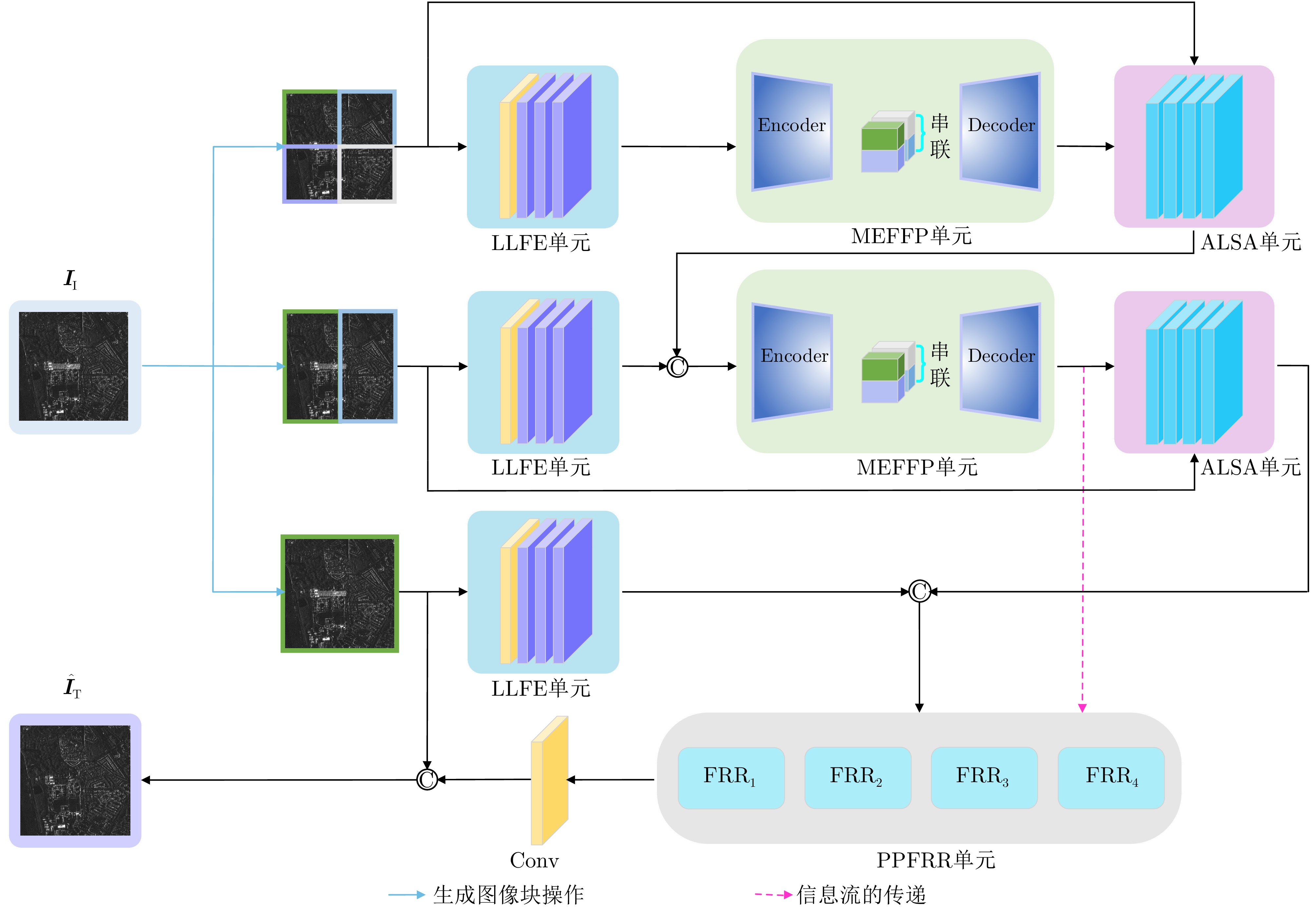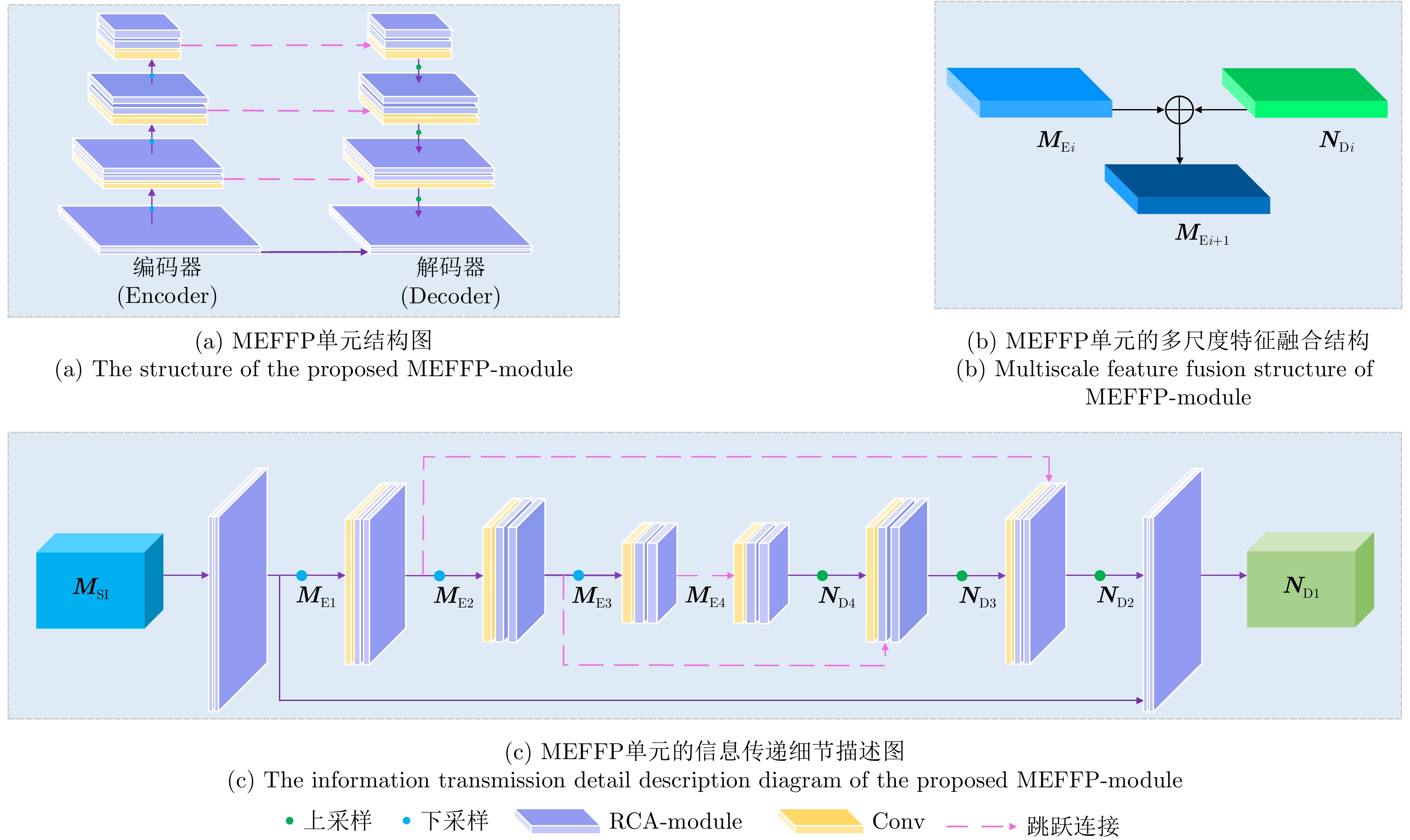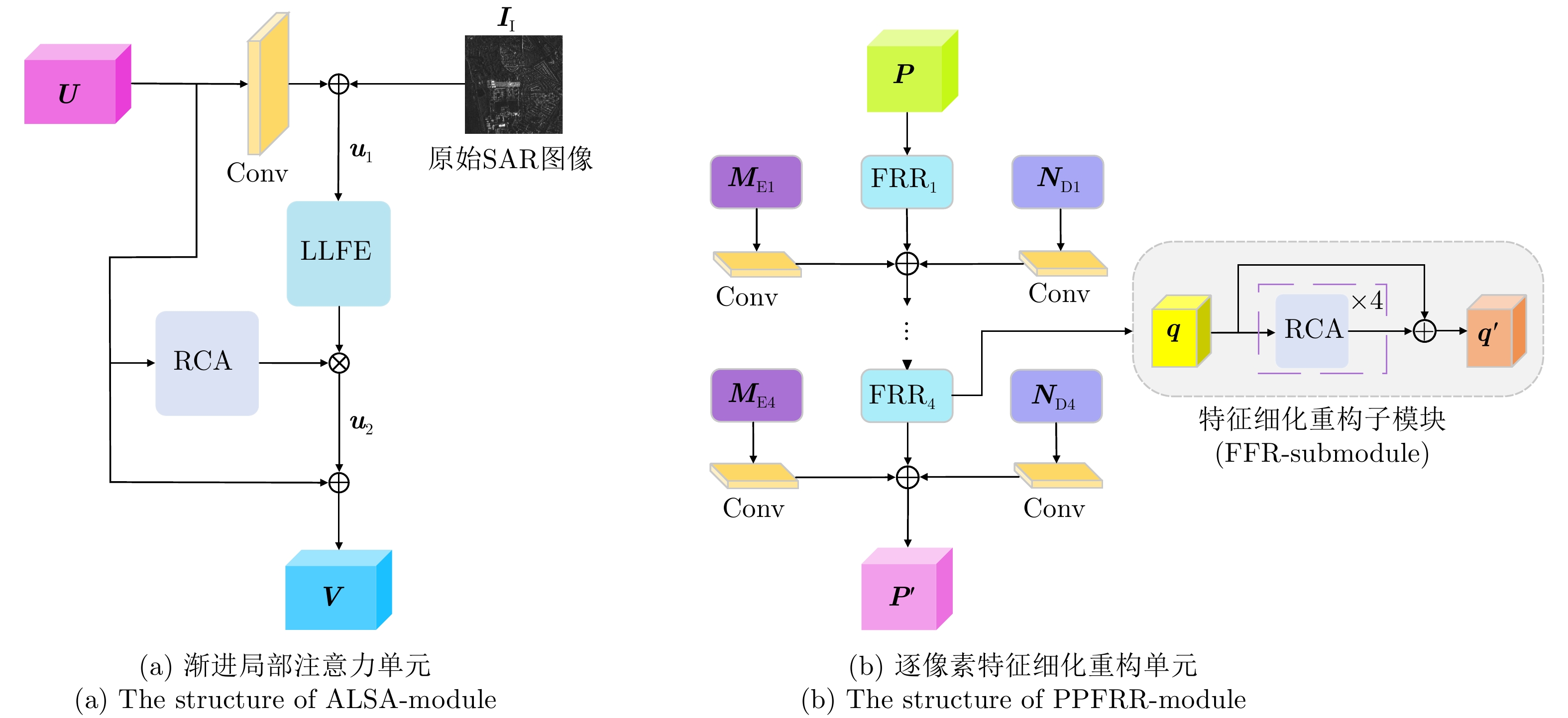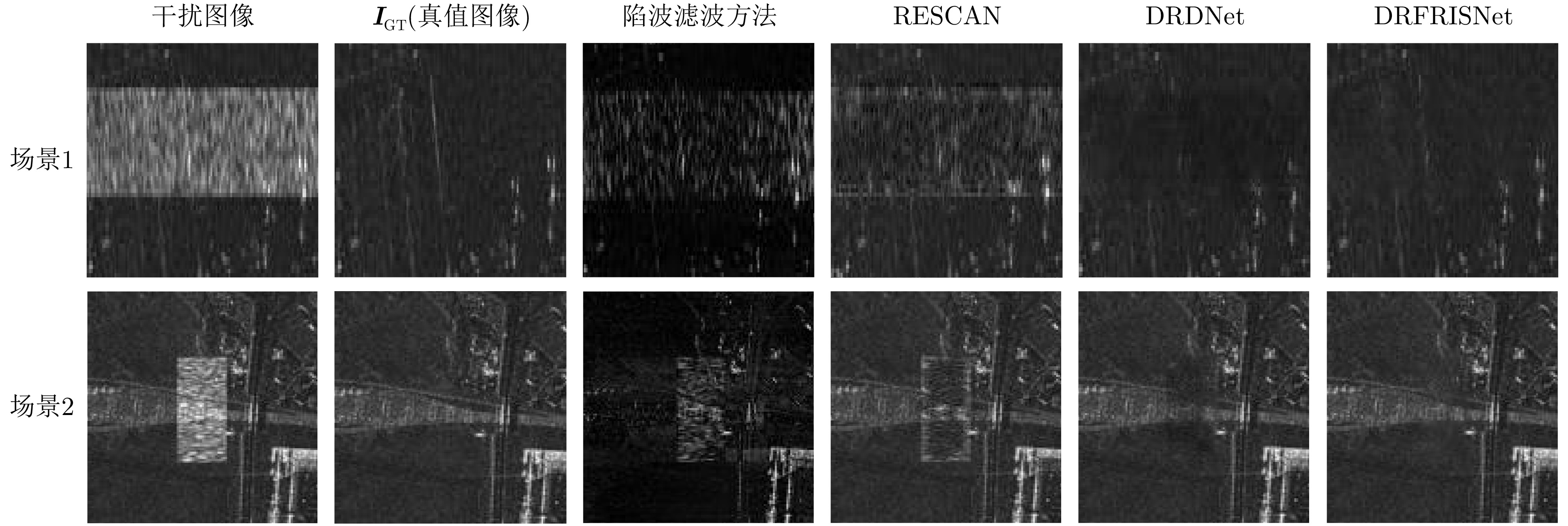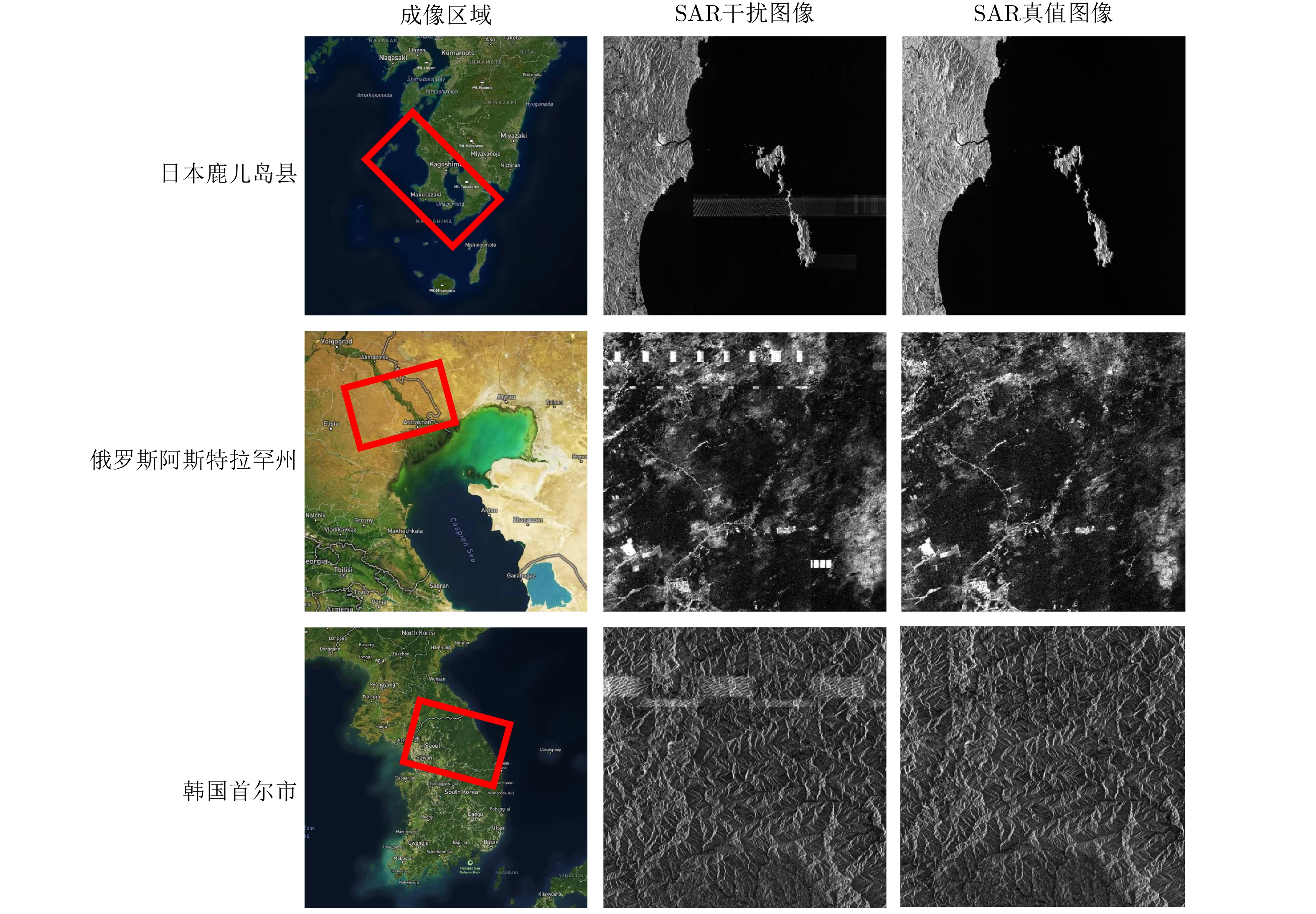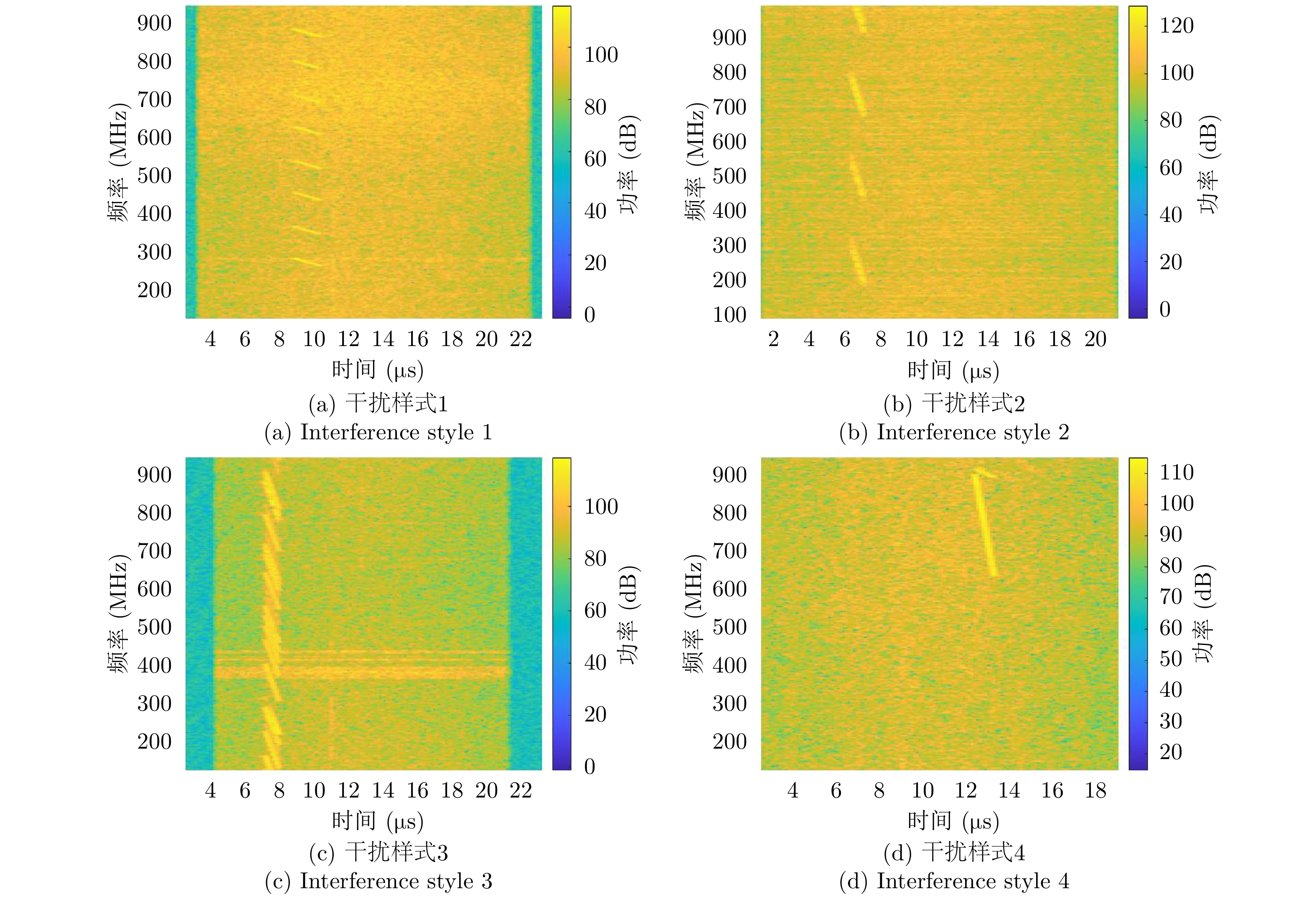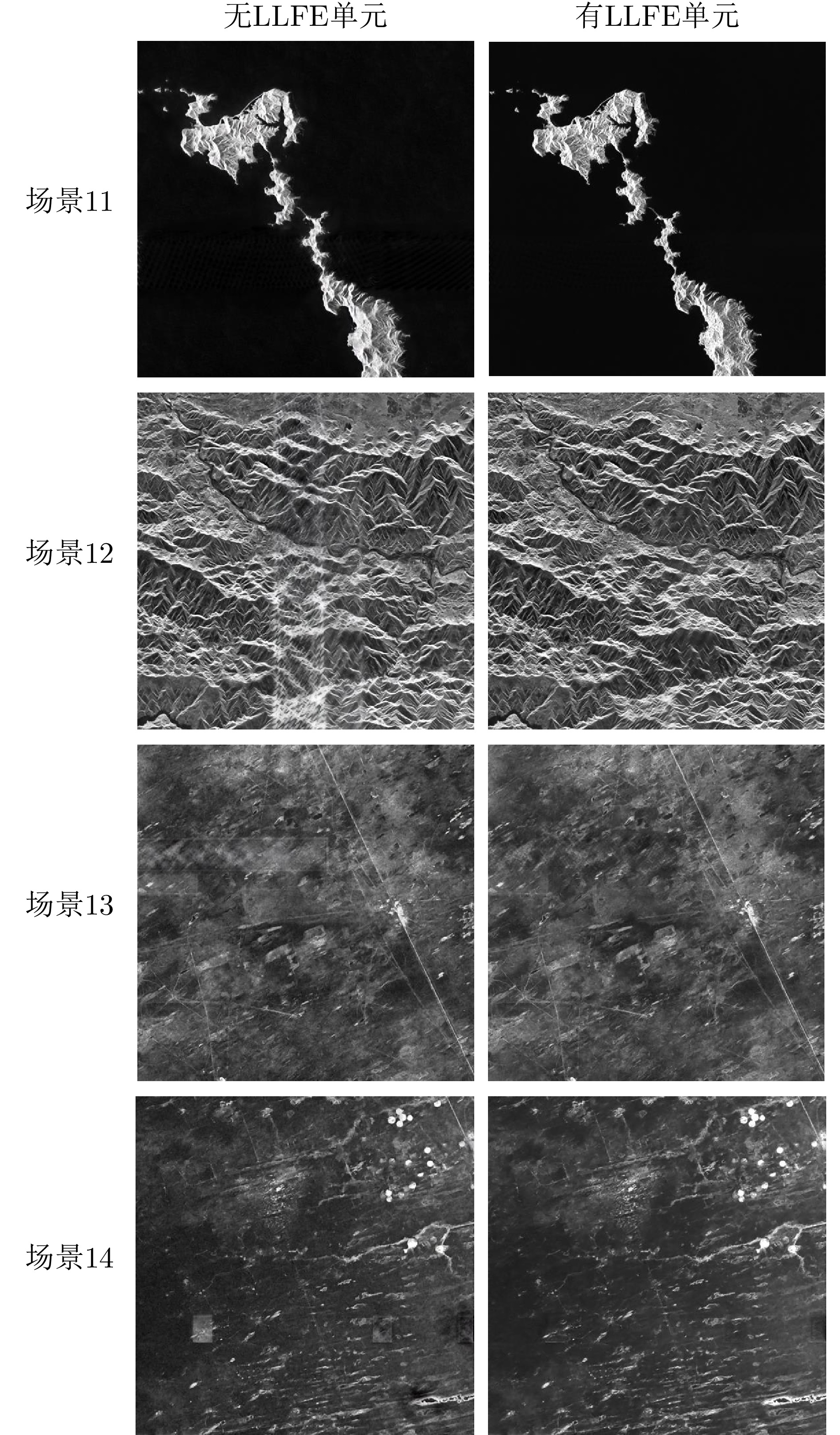Article Navigation >
Journal of Radars
>
2024
> Proofreading [3rd]
| Citation: | NIE Lin, WEI Shunjun, LI Jiahui, et al. Active blanket jamming suppression method for spaceborne SAR images based on regional feature refinement perceptual learning[J]. Journal of Radars, in press. doi: 10.12000/JR24072 |
Active Blanket Jamming Suppression Method for Spaceborne SAR Images Based on Regional Feature Refinement Perceptual Learning
doi: 10.12000/JR24072
More Information-
Abstract
Spaceborne Synthetic Aperture Radar (SAR) systems are often subject to strong electromagnetic interference, resulting in imaging quality degradation. However, existing image domain-based interference suppression methods are prone to image distortion and loss of texture detail information, among other difficulties. To address these problems, this paper proposes a method for suppressing active suppression interferences inspaceborne SAR images based on perceptual learning of regional feature refinement. First, an active suppression interference signal and image model is established in the spaceborne SAR image domain. Second, a high-precision interference recognition network based on regional feature perception is designed to extract the active suppression interference pattern features of the involved SAR image using an efficient channel attention mechanism, consequently resulting in effective recognition of the interference region of the SAR image. Third, a multivariate regional feature refinement interference suppression network is constructed based on the joint learning of the SAR image and suppression interference features, which are combined to form the SAR image and suppression interference pattern. A feature refinement interference suppression network is then constructed based on the joint learning of the SAR image and suppression interference feature. The network slices the SAR image into multivariate regions, and adopts multi-module collaborative processing of suppression interference features on the multivariate regions to realize refined suppression of the active suppression interference of the SAR image under complex conditions. Finally, a simulation dataset of SAR image active suppression interference is constructed, and the evaluated Sentinel-1 data are used for experimental verification and analysis. The experimental results show that the proposed method can effectively recognize and suppress various typical active suppression interferences in spaceborne SAR images. -

-
References
[1] 杨建宇. 雷达对地成像技术多向演化趋势与规律分析[J]. 雷达学报, 2019, 8(6): 669–692. doi: 10.12000/JR19099.YANG Jianyu. Multi-directional evolution trend and law analysis of radar ground imaging technology[J]. Journal of Radars, 2019, 8(6): 669–692. doi: 10.12000/JR19099.[2] 吴一戎, 朱敏慧. 合成孔径雷达技术的发展现状与趋势[J]. 遥感技术与应用, 2000, 15(2): 121–123. doi: 10.3969/j.issn.1004-0323.2000.02.012.WU Yirong and ZHU Minhui. The developing status and trends of synthetic aperture radar[J]. Remote Sensing Technology and Application, 2000, 15(2): 121–123. doi: 10.3969/j.issn.1004-0323.2000.02.012.[3] 邓云凯, 禹卫东, 张衡, 等. 未来星载SAR技术发展趋势[J]. 雷达学报, 2020, 9(1): 1–33. doi: 10.12000/JR20008.DENG Yunkai, YU Weidong, ZHANG Heng, et al. Forthcoming spaceborne SAR development[J]. Journal of Radars, 2020, 9(1): 1–33. doi: 10.12000/JR20008.[4] 王谋, 韦顺军, 沈蓉, 等. 基于自学习稀疏先验的三维SAR成像方法[J]. 雷达学报, 2023, 12(1): 36–52. doi: 10.12000/JR22101.WANG Mou, WEI Shunjun, SHEN Rong, et al. 3D SAR imaging method based on learned sparse prior[J]. Journal of Radars, 2023, 12(1): 36–52. doi: 10.12000/JR22101.[5] ZHANG Hao, WEI Shunjun, WANG Mou, et al. FUAS-Net: Feature-oriented unsupervised network for FMCW radar interference suppression[J]. IEEE Transactions on Microwave Theory and Techniques, 2024, 72(4): 2602–2619. doi: 10.1109/TMTT.2023.3318669.[6] WANG Mou, WEI Shunjun, ZHOU Zichen, et al. Efficient ADMM framework based on functional measurement model for mmW 3-D SAR imaging[J]. IEEE Transactions on Geoscience and Remote Sensing, 2022, 60: 5226417. doi: 10.1109/TGRS.2022.3165541.[7] WANG Mou, WEI Shunjun, ZHOU Zichen, et al. CTV-Net: Complex-valued TV-driven network with nested topology for 3-D SAR imaging[J]. IEEE Transactions on Neural Networks and Learning Systems, 2024, 35(4): 5588–5602. doi: 10.1109/TNNLS.2022.3208252.[8] 林晓烘. 星载合成孔径雷达干扰与抗干扰技术研究[D]. [博士论文], 国防科学技术大学, 2014.LIN Xiaohong. Study on jamming and anti-jamming techniques for spaceborne synthetic aperture radar[D]. [Ph.D. dissertation], National University of Defense Technology, 2014.[9] 黄岩, 赵博, 陶明亮, 等. 合成孔径雷达抗干扰技术综述[J]. 雷达学报, 2020, 9(1): 86–106. doi: 10.12000/JR19113.HUANG Yan, ZHAO Bo, TAO Mingliang, et al. Review of synthetic aperture radar interference suppression[J]. Journal of Radars, 2020, 9(1): 86–106. doi: 10.12000/JR19113.[10] LAMONT-SMITH T, HILL R D, HAYWARD S D, et al. Filtering approaches for interference suppression in low-frequency SAR[J]. IEE Proceedings-Radar, Sonar and Navigation, 2006, 153(4): 338–344. doi: 10.1049/ip-rsn:20050092.[11] 韩朝赟, 岑熙, 崔嘉禾, 等. 纹理异常感知SAR自监督学习干扰抑制方法[J]. 雷达学报, 2023, 12(1): 154–172. doi: 10.12000/JR22168.HAN Zhaoyun, CEN Xi, CUI Jiahe, et al. Self-supervised learning method for SAR interference suppression based on abnormal texture perception[J]. Journal of Radars, 2023, 12(1): 154–172. doi: 10.12000/JR22168.[12] ZHOU Feng, WU Renbiao, XING Mengdao, et al. Eigensubspace-based filtering with application in narrow-band interference suppression for SAR[J]. IEEE Geoscience and Remote Sensing Letters, 2007, 4(1): 75–79. doi: 10.1109/LGRS.2006.887033.[13] LIU Zhiling, LIAO Guisheng, and YANG Zhiwei. Time variant RFI suppression for SAR using iterative adaptive approach[J]. IEEE Geoscience and Remote Sensing Letters, 2013, 10(6): 1424–1428. doi: 10.1109/LGRS.2013.2259575.[14] SU Jia, TAO Haihong, TAO Mingliang, et al. Narrow-band interference suppression via RPCA-based signal separation in time-frequency domain[J]. IEEE Journal of Selected Topics in Applied Earth Observations and Remote Sensing, 2017, 10(11): 5016–5025. doi: 10.1109/JSTARS.2017.2727520.[15] HUANG Yan, LIAO Guisheng, XU Jingwei, et al. Narrowband RFI suppression for SAR system via efficient parameter-free decomposition algorithm[J]. IEEE Transactions on Geoscience and Remote Sensing, 2018, 56(6): 3311–3322. doi: 10.1109/TGRS.2018.2797946.[16] REIGBER A and FERRO-FAMIL L. Interference suppression in synthesized SAR images[J]. IEEE Geoscience and Remote Sensing Letters, 2005, 2(1): 45–49. doi: 10.1109/LGRS.2004.838419.[17] YANG Huizhang, LI Kun, LI Jie, et al. BSF: Block subspace filter for removing narrowband and wideband radio interference artifacts in single-look complex SAR images[J]. IEEE Transactions on Geoscience and Remote Sensing, 2022, 60: 5211916. doi: 10.1109/TGRS.2021.3096538.[18] YANG Huizhang, HE Yaomin, DU Yanlei, et al. Two-dimensional spectral analysis filter for removal of LFM radar interference in spaceborne SAR imagery[J]. IEEE Transactions on Geoscience and Remote Sensing, 2022, 60: 5219016. doi: 10.1109/TGRS.2021.3132495.[19] YANG Huizhang, LANG Ping, LU Xingyu, et al. Robust block subspace filtering for efficient removal of radio interference in synthetic aperture radar images[J]. IEEE Transactions on Geoscience and Remote Sensing, 2024, 62: 5206812. doi: 10.1109/TGRS.2024.3369021.[20] 陈爽. 基于深度学习的雷达有源欺骗干扰识别方法[D]. [硕士论文], 电子科技大学, 2023. doi: 10.27005/d.cnki.gdzku.2023.001330.CHEN Shuang. Identification method of radar active deception jamming based on deep learning[D]. [Master dissertation], University of Electronic Science and Technology of China, 2023. doi: 10.27005/d.cnki.gdzku.2023.001330.[21] 陈思伟, 崔兴超, 李铭典, 等. 基于深度CNN模型的SAR图像有源干扰类型识别方法[J]. 雷达学报, 2022, 11(5): 897–908. doi: 10.12000/JR22143.CHEN Siwei, CUI Xingchao, LI Mingdian, et al. SAR image active jamming type recognition based on deep CNN model[J]. Journal of Radars, 2022, 11(5): 897–908. doi: 10.12000/JR22143.[22] 张顺生, 陈爽, 陈晓莹, 等. 面向小样本的多模态雷达有源欺骗干扰识别方法[J]. 雷达学报, 2023, 12(4): 882–891. doi: 10.12000/JR23104.ZHANG Shunsheng, CHEN Shuang, CHEN Xiaoying, et al. Active deception jamming recognition method in multimodal radar based on small samples[J]. Journal of Radars, 2023, 12(4): 882–891. doi: 10.12000/JR23104.[23] FAN Weiwei, ZHOU Feng, TAO Mingliang, et al. Interference mitigation for synthetic aperture radar based on deep residual network[J]. Remote Sensing, 2019, 11(14): 1654. doi: 10.3390/rs11141654.[24] CHEN Shengyi, SHANGGUAN Wangyi, TAGHIA J, et al. Automotive radar interference mitigation based on a generative adversarial network[C]. 2020 IEEE Asia-Pacific Microwave Conference, Hong Kong, China, 2020: 728–730. doi: 10.1109/APMC47863.2020.9331379.[25] SHEN Jiayuan, HAN Bing, PAN Zongxu, et al. Radio frequency interference suppression in SAR system using prior-induced deep neural network[C]. 2022 IEEE International Geoscience and Remote Sensing Symposium, Kuala Lumpur, Malaysia, 2022: 943–946. doi: 10.1109/IGARSS46834.2022.9883464.[26] WEI Yanyan, ZHANG Zhao, ZHANG Haijun, et al. A coarse-to-fine multi-stream hybrid deraining network for single image deraining[C]. 2019 IEEE International Conference on Data Mining, Beijing, China, 2019: 628–637. doi: 10.1109/ICDM.2019.00073.[27] WU Haiyan, QU Yanyun, LIN Shaohui, et al. Contrastive learning for compact single image dehazing[C]. 2021 IEEE/CVF Conference on Computer Vision and Pattern Recognition, Nashville, USA, 2021: 10546–10555. doi: 10.1109/CVPR46437.2021.01041.[28] HONG Ming, XIE Yuan, LI Cuihua, et al. Distilling image dehazing with heterogeneous task imitation[C]. 2020 IEEE/CVF Conference on Computer Vision and Pattern Recognition, Seattle, USA, 2020: 3459–3468. doi: 10.1109/CVPR42600.2020.00352.[29] CUI Xin, WANG Cong, REN Dongwei, et al. Semi-supervised image deraining using knowledge distillation[J]. IEEE Transactions on Circuits and Systems for Video Technology, 2022, 32(12): 8327–8341. doi: 10.1109/TCSVT.2022.3190516.[30] LI Ning, LV Zongsen, and GUO Zhengwei. Observation and mitigation of mutual RFI between SAR satellites: A case study between Chinese GaoFen-3 and European Sentinel-1A[J]. IEEE Transactions on Geoscience and Remote Sensing, 2022, 60: 5112819. doi: 10.1109/TGRS.2022.3170363.[31] YANG Huizhang, TAO Mingliang, CHEN Shengyao, et al. On the mutual interference between spaceborne SARs: Modeling, characterization, and mitigation[J]. IEEE Transactions on Geoscience and Remote Sensing, 2021, 59(10): 8470–8485. doi: 10.1109/TGRS.2020.3036635.[32] 曲婧华. 有源噪声调制干扰的仿真及性能分析[J]. 空军工程大学学报: 自然科学版, 2007, 8(1): 44–46.QU Jinghua. Simulation and analysis of complex active noise modulation jamming[J]. Journal of Air Force Engineering University: Natural Science Edition, 2007, 8(1): 44–46.[33] 殷加鹏, 李健兵, 庞晨, 等. 一种极化-多普勒气象雷达的射频干扰滤波方法[J]. 雷达学报, 2021, 10(6): 905–918. doi: 10.12000/JR21102.YIN Jiapeng, LI Jianbing, PANG Chen, et al. A radio frequency interference mitigation method for polarimetric Doppler weather radars[J]. Journal of Radars, 2021, 10(6): 905–918. doi: 10.12000/JR21102.[34] 房明星, 王杰贵, 雷磊. SAR雷达二维噪声卷积调制干扰研究[J]. 现代防御技术, 2014, 42(2): 139–144, 160. doi: 10.3969/j.issn.1009-086x.2014.02.025.FANG Mingxing, WANG Jiegui, and LEI Lei. Study on 2D noise convolution modulation jamming to SAR[J]. Modern Defense Technology, 2014, 42(2): 139–144, 160. doi: 10.3969/j.issn.1009-086x.2014.02.025.[35] 黄洪旭, 黄知涛, 周一宇. 对合成孔径雷达的移频干扰研究[J]. 宇航学报, 2006, 27(3): 463–468. doi: 10.3321/j.issn:1000-1328.2006.03.027.HUANG Hongxu, HUANG Zhitao, and ZHOU Yiyu. A study on the shift-frequency jamming to SAR[J]. Journal of Astronautics, 2006, 27(3): 463–468. doi: 10.3321/j.issn:1000-1328.2006.03.027.[36] WANG Qilong, WU Banggu, ZHU Pengfei, et al. ECA-Net: Efficient channel attention for deep convolutional neural networks[C]. 2020 IEEE/CVF Conference on Computer Vision and Pattern Recognition, Seattle, USA, 2020: 11531–11539. doi: 10.1109/CVPR42600.2020.01155.[37] OYEDOTUN O K, AL ISMAEIL K, and AOUADA D. Why is everyone training very deep neural network with skip connections?[J]. IEEE Transactions on Neural Networks and Learning Systems, 2023, 34(9): 5961–5975. doi: 10.1109/TNNLS.2021.3131813.[38] ZHANG Hongguang, DAI Yuchao, LI Hongdong, et al. Deep stacked hierarchical multi-patch network for image deblurring[C]. 2019 IEEE/CVF Conference on Computer Vision and Pattern Recognition, Long Beach, USA, 2019: 5971–5979. doi: 10.1109/CVPR.2019.00613.[39] ZAMIR S W, ARORA A, KHAN S, et al. Multi-stage progressive image restoration[C]. 2021 IEEE/CVF Conference on Computer Vision and Pattern Recognition, Nashville, USA, 2021: 14816–14826. doi: 10.1109/CVPR46437.2021.01458.[40] BARRON J T. A general and adaptive robust loss function[C]. 2019 IEEE/CVF Conference on Computer Vision and Pattern Recognition, Long Beach, USA, 2019: 4326–4334. doi: 10.1109/CVPR.2019.00446.[41] SEIF G and ANDROUTSOS D. Edge-based loss function for single image super-resolution[C]. 2018 IEEE International Conference on Acoustics, Speech and Signal Processing, Calgary, Canada, 2018: 1468–1472. doi: 10.1109/ICASSP.2018.8461664.[42] 朱铮涛, 黎绍发, 陈华平. 基于图像熵的自动聚焦函数研究[J]. 光学精密工程, 2004, 12(5): 537–542. doi: 10.3321/j.issn:1004-924X.2004.05.014.ZHU Zhengtao, LI Shaofa, and CHEN Huaping. Research on auto-focused function based on the image entropy[J]. Optics and Precision Engineering, 2004, 12(5): 537–542. doi: 10.3321/j.issn:1004-924X.2004.05.014.[43] 王凡, 倪晋平, 董涛, 等. 结合视觉注意力机制和图像锐度的无参图像质量评价方法[J]. 应用光学, 2018, 39(1): 51–56. doi: 10.5768/JAO201839.0102002.WANG Fan, NI Jinping, DONG Tao, et al. No-reference image quality assessment method based on visual attention mechanism and sharpness metric approach[J]. Journal of Applied Optics, 2018, 39(1): 51–56. doi: 10.5768/JAO201839. 0102002.[44] 王俊平, 李锦. 图像对比度增强研究的进展[J]. 电子科技, 2013, 26(5): 160–165. doi: 10.16180/j.cnki.issn1007-7820.2013.05.045.WANG Junping and LI Jin. Development and prospect of image contrast enhancement[J]. Electronic Science & Technology, 2013, 26(5): 160–165. doi: 10.16180/j.cnki.issn1007-7820.2013.05.045.[45] HORÉ A and ZIOU D. Image quality metrics: PSNR vs. SSIM[C]. 2010 20th International Conference on Pattern Recognition, Istanbul, Turkey, 2010: 2366–2369. doi: 10.1109/ICPR.2010.579.[46] BAKUROV I, BUZZELLI M, SCHETTINI R, et al. Structural similarity index (SSIM) revisited: A data-driven approach[J]. Expert Systems with Applications, 2022, 189: 116087. doi: 10.1016/j.eswa.2021.116087.[47] GUPTA N and AGARWAL B B. Suspicious activity classification in classrooms using deep learning[J]. Engineering, Technology & Applied Science Research, 2023, 13(6): 12226–12230. doi: 10.48084/etasr.6228.[48] WU Bichen, DAI Xiaoliang, ZHANG Peizhao, et al. FBNet: Hardware-aware efficient ConvNet design via differentiable neural architecture search[C]. 2019 IEEE/CVF Conference on Computer Vision and Pattern Recognition, Long Beach, USA, 2019: 10726–10734. doi: 10.1109/CVPR.2019.01099.[49] CHEN Zhao, JIANG Yin, ZHANG Xiaoyu, et al. ResNet18DNN: Prediction approach of drug-induced liver injury by deep neural network with ResNet18[J]. Briefings in Bioinformatics, 2022, 23(1): bbab503. doi: 10.1093/bib/bbab503.[50] TAN Mingxing, CHEN Bo, PANG Ruoming, et al. MnasNet: Platform-aware neural architecture search for mobile[C]. 2019 IEEE/CVF Conference on Computer Vision and Pattern Recognition, Long Beach, USA, 2019: 2815–2823. doi: 10.1109/CVPR.2019.00293.[51] 张晓明, 王莎莎. 针对窄带干扰抑制的数字陷波器设计[J]. 无线电工程, 2008, 38(5): 24–25, 52. doi: 10.3969/j.issn.1003-3106.2008.05.008.ZHANG Xiaoming and WANG Shasha. Methods for IIR digital notch filter to suppress narrow-band interference[J]. Radio Engineering, 2008, 38(5): 24–25, 52. doi: 10.3969/j.issn.1003-3106.2008.05.008.[52] 刘江, 李健聪, 蔡伯根, 等. 基于自适应陷波滤波的列车卫星定位窄带干扰防护[J]. 铁道学报, 2022, 44(5): 49–59. doi: 10.3969/j.issn.1001-8360.2022.05.007.LIU Jiang, LI Jiancong, CAI Bogen, et al. Narrow-band interference protection for satellite-based train positioning based on adaptive notch filter[J]. Journal of the China Railway Society, 2022, 44(5): 49–59. doi: 10.3969/j.issn.1001-8360.2022.05.007.[53] LI Xia, WU Jianlong, LIN Zhouchen, et al. Recurrent squeeze-and-excitation context aggregation net for single image deraining[C]. 15th European Conference, Munich, Germany, 2018: 262–277. doi: 10.1007/978-3-030-01234-2_16.[54] DENG Sen, WEI Mingqiang, WANG Jun, et al. Detail-recovery image deraining via context aggregation networks[C]. 2020 IEEE/CVF Conference on Computer Vision and Pattern Recognition, Seattle, USA, 2020: 14548–14557. doi: 10.1109/CVPR42600.2020.01457. -
Proportional views

- Figure 1. Spaceborne SAR suppression jamming geometry
- Figure 2. Flowchart of the proposed interference suppression method
- Figure 3. The structure of the proposed IRRFPNet
- Figure 4. The structure of the proposed DRFRISNet
- Figure 5. The structure of LLFE-module
- Figure 6. The schematic diagram of MEFFP-module
- Figure 7. The structure of ALSA-module and PPFRR-module
- Figure 8. Simulation data correspondence area
- Figure 9. Comparison of loss value and mean overall accuracy of five networks in training process
- Figure 10. Results of interference suppression simulation experiments
- Figure 11. Enlarged view of the interference region of Fig. 10 scenario 1 and scenario 2
- Figure 12. Large scenario regions corresponding to measured data (where the red box indicates the imaging area)
- Figure 13. Time-frequency spectra of interference slices in the measured data
- Figure 14. Experimental results of interference suppression measurement experiments on Sentinel-1 data
- Figure 15. Enlarged view of the interference region of Fig. 14(c) and Fig. 14(d)
- Figure 16. Ablation experiments on LLFE with real data


 Submit Manuscript
Submit Manuscript Peer Review
Peer Review Editor Work
Editor Work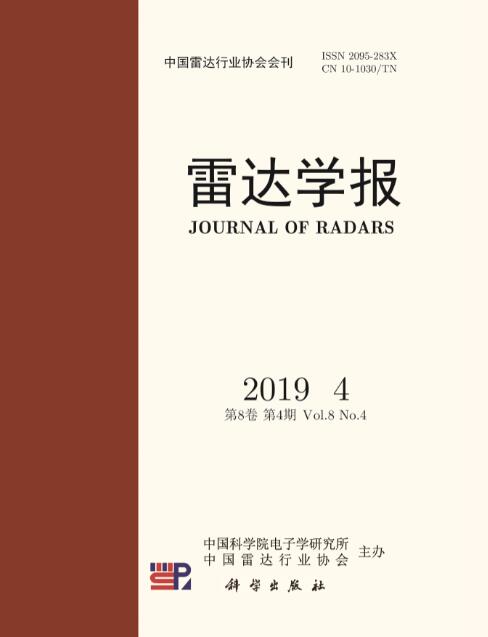

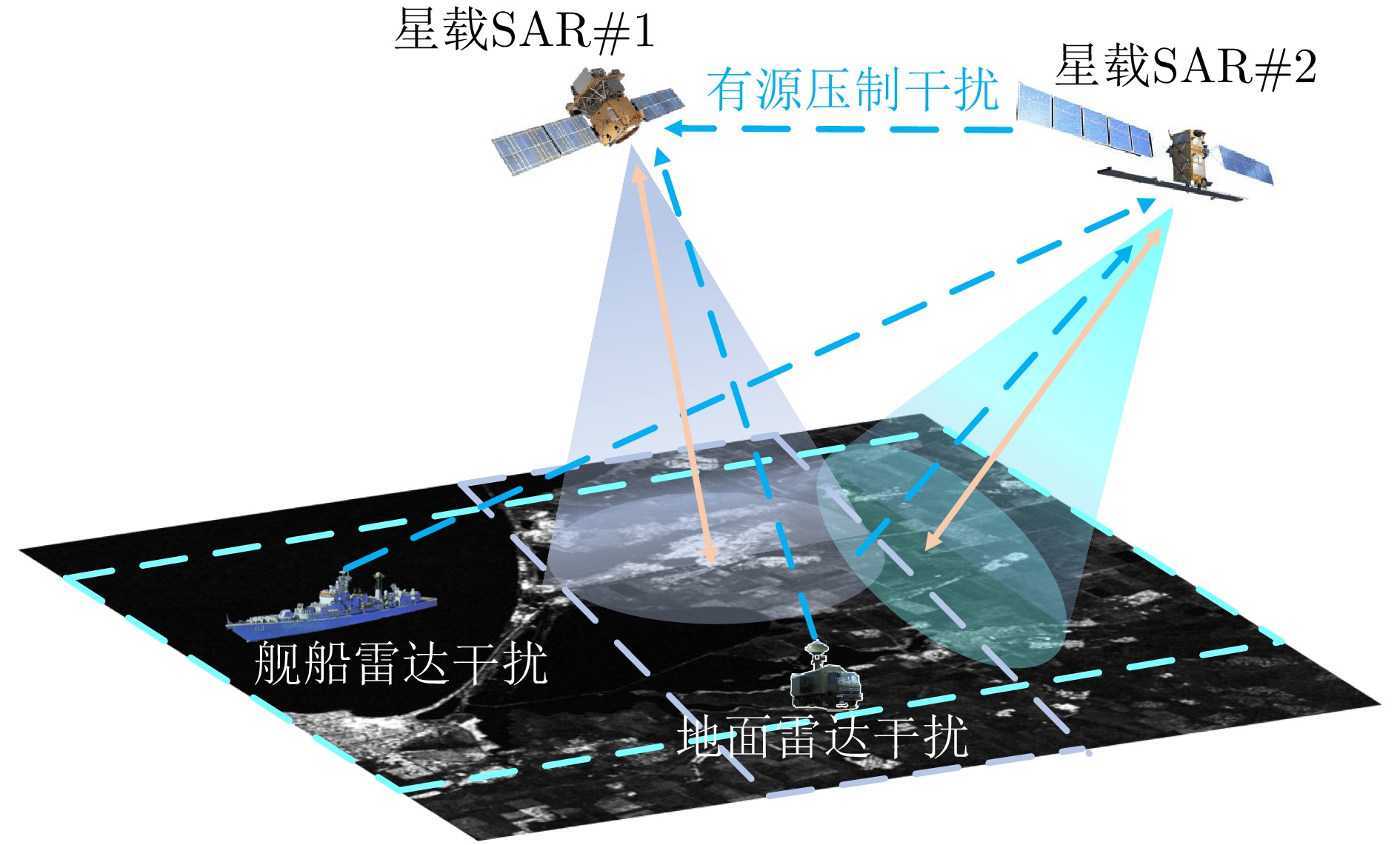



 DownLoad:
DownLoad:


